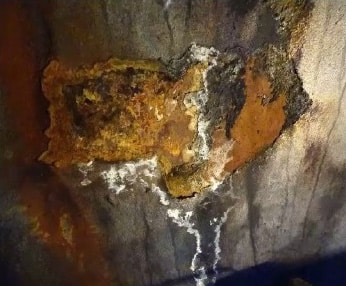PROBLEM: A gas plant in the Middle East identified internal corrosion in its amine process columns
SOLUTION: #1: IGS HVTS was applied in two columns #2: Local thermal spray contractor applied conventional low velocity thermal spray system in six columns
RESULT: Inspection after six years in service revealed IGS HVTS to be in excellent condition. Conventional thermal spray coating failed exposing the shell to further corrosion.
In 2015, a gas plant in the Middle East identified internal corrosion in two of its amine process columns and contracted Integrated Global Services (IGS) to apply High Velocity Thermal Spray (HVTS) alloy cladding to protect the base metal. The HVTS cladding was applied by experienced IGS operators with thorough process and quality tests in place. In 2016, the plant went out to public tender for the completion of a similar work scope on six more columns. The final companies in contention were IGS and a local thermal spray contractor, with the latter winning the contract on a cost basis. The local thermal spray company carried out the work at the gas plant using a conventional low velocity thermal spray process technology.
The Inspections
The first inspection of the two columns protected by IGS HVTS took place in 2018, with no signs of further corrosion and the protective cladding in excellent, as-applied condition.
A further inspection by the plant’s senior corrosion engineer in November 2021 revealed a staggering contrast between the two columns sprayed by IGS in 2015 and the other columns sprayed by the local thermal spray contractor in 2016. The HVTS applied by IGS was still in excellent condition, with no signs of cracking or failure. However, the other columns sprayed with the low velocity thermal spray showed extreme signs of breakdown of the applied cladding and corrosion of the substrate, with the wall thickness loss threatening to exceed its maximum corrosion allowance.


If left, the ongoing corrosion could result in an unplanned shutdown, potentially costing millions of dollars in lost revenue. In the best-case scenario, the column would need to be stripped of the remaining cladding, undergo mechanical repairs (which is both costly and time consuming), and then be protected with a long-lasting IGS HVTS.
The Science
This scenario is a common occurrence at many oil and gas plants, refineries, and petrochemical sites. Although the initial cost is often far less, the long-term expense far outweighs the short-term savings. To understand why the low velocity system failed, we must understand the science behind various types of materials and application methodology.
Material Modification
Standard welding alloys are unsuitable materials for thermal spray application in critical internal process equipment, as the cladding particles form oxides on their surface in flight, creating a fundamental weakness in the microstructure and permeability. IGS develops alloys designed and modified for high performance thermal spray application.
True High Velocity Application Technology
IGS HVTS conveyance technologies atomise the bespoke wire feedstock in a supersonic gas stream, producing a cladding that consists of flat and tightly packed micro-sized particles. Conventionally available thermal spray application systems cannot produce equivalent particle sizes. They have a more open microstructure and do not impart sufficient energy to flatten the particles that are inherently highly stressed. These shortcomings lead to premature failure due to permeation from microstructural weaknesses and cracking of the coating.
IGS Comment
Dennis Snijders, Sr. Regional Director – Middle East & North Africa at IGS, commented:
“The results we have seen at this particular plant really confirm the performance difference between IGS HVTS and a conventional thermal spray coating applied by a local contractor. Through research and development, we know that HVTS completely eliminates the corrosion process. However, it is always reassuring to visually see the difference between the columns IGS sprayed in 2015 and the columns sprayed with a low velocity thermal spray.
“Our system and application process has been successful in preventing any further degradation or wastage since 2015 and resulted in significant savings for our client. The client is very impressed with the results we have achieved, and if there is a moral to this story, it is that a short-term saving often has a substantial long-term cost.”
CATEGORIES:
IGS is here to provide information, answer questions and create an effective solution for your needs.